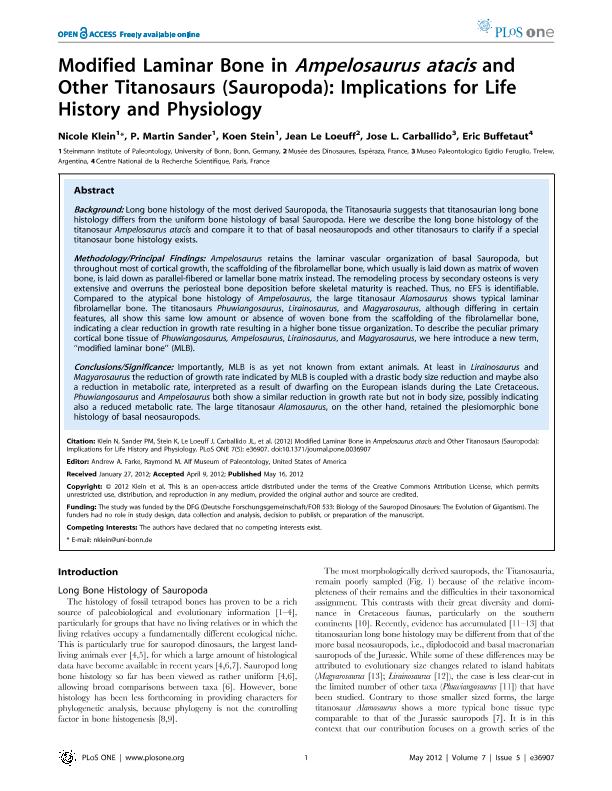Artículo
Modified laminar bone in Ampelosaurus atacis and other titanosaurs (Sauropoda): Implications for life history and physiology
Klein, Nicole; Sander, P. Martin; Stein, koen; Loeuff, L. Jean.; Carballido, José Luis ; Buffetaut, Éric
; Buffetaut, Éric
 ; Buffetaut, Éric
; Buffetaut, Éric
Fecha de publicación:
05/2012
Editorial:
Public Library of Science
Revista:
Plos One
ISSN:
1932-6203
Idioma:
Inglés
Tipo de recurso:
Artículo publicado
Clasificación temática:
Resumen
Background: Long bone histology of the most derived Sauropoda, the Titanosauria suggests that titanosaurian long bone histology differs from the uniform bone histology of basal Sauropoda. Here we describe the long bone histology of the titanosaur Ampelosaurus atacis and compare it to that of basal neosauropods and other titanosaurs to clarify if a special titanosaur bone histology exists. Methodology/Principal Findings: Ampelosaurus retains the laminar vascular organization of basal Sauropoda, but throughout most of cortical growth, the scaffolding of the fibrolamellar bone, which usually is laid down as matrix of woven bone, is laid down as parallel-fibered or lamellar bone matrix instead. The remodeling process by secondary osteons is very extensive and overruns the periosteal bone deposition before skeletal maturity is reached. Thus, no EFS is identifiable. Compared to the atypical bone histology of Ampelosaurus, the large titanosaur Alamosaurus shows typical laminar fibrolamellar bone. The titanosaurs Phuwiangosaurus, Lirainosaurus, and Magyarosaurus, although differing in certain features, all show this same low amount or absence of woven bone from the scaffolding of the fibrolamellar bone, indicating a clear reduction in growth rate resulting in a higher bone tissue organization. To describe the peculiar primary cortical bone tissue of Phuwiangosaurus, Ampelosaurus, Lirainosaurus, and Magyarosaurus, we here introduce a new term, "modified laminar bone" (MLB). Conclusions/Significance: Importantly, MLB is as yet not known from extant animals. At least in Lirainosaurus and Magyarosaurus the reduction of growth rate indicated by MLB is coupled with a drastic body size reduction and maybe also a reduction in metabolic rate, interpreted as a result of dwarfing on the European islands during the Late Cretaceous. Phuwiangosaurus and Ampelosaurus both show a similar reduction in growth rate but not in body size, possibly indicating also a reduced metabolic rate. The large titanosaur Alamosaurus, on the other hand, retained the plesiomorphic bone histology of basal neosauropods.
Palabras clave:
Ampelosaurus
,
Titanosauria
,
Histology
,
modified laminar bone
Archivos asociados
Licencia
Identificadores
Colecciones
Articulos(SEDE CENTRAL)
Articulos de SEDE CENTRAL
Articulos de SEDE CENTRAL
Citación
Klein, Nicole; Sander, P. Martin; Stein, koen; Loeuff, L. Jean.; Carballido, José Luis; et al.; Modified laminar bone in Ampelosaurus atacis and other titanosaurs (Sauropoda): Implications for life history and physiology; Public Library of Science; Plos One; 7; 5; 5-2012; 1-17
Compartir
Altmétricas



